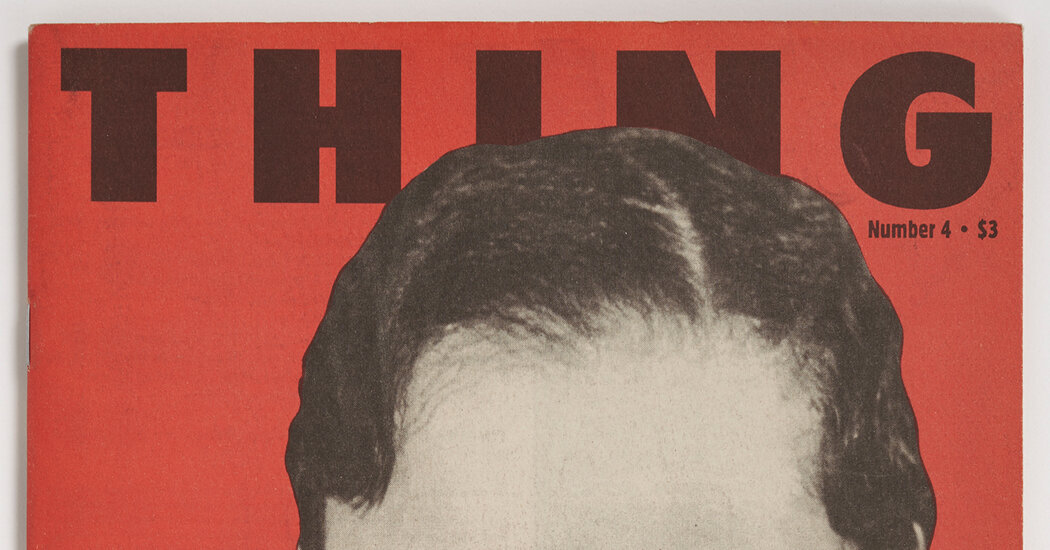Before the internet, before the spicy comments sections on Instagram and Twitter or the outré subcultures on TikTok, like-minded strangers connected through zines. What is a zine?
The curators of “Copy Machine Manifestos: Artists Who Make Zines” at the Brooklyn Museum, the art historians Branden Joseph and Drew Sawyer, define them as low-budget, limited-circulation publications (short for “magazine” or “fanzine”) that are not political pamphlets or countercultural newspapers.
The show’s territory starts in 1969, coinciding with the widening availability of photocopy machines, and runs to the present. The selection of zines, posters, films, videos, paintings, garments and other curios is pretty great, and you see many repeat visitors (like myself) wandering the galleries. There is an enormous amount of material to take in.
There is a distinct crossover between punk rock and zine culture, with its critique of conformism, capitalism and mainstream music. The bondage-inspired aesthetics of punk are captured in Bruce LaBruce’s films and zines, while schlocky horror movies and pulp fiction are obvious inspirations for others. Some zines are direct responses to other publications, like Vile and File, which take the layout and design of Life magazine and turn these into racier, punk-like versions. Later zines delve more into early ’90s identity politics.
One of the standouts of this section (and the whole show, really) is Vaginal Davis, whose Fertile La Toyah Jackson Magazine plays with fame, gender, race and drag culture. A founder of ’90s Los Angeles “homocore,” which blended queer and alternative music communities, Davis’s video “The White to Be Angry” (1999) looks at white supremacist culture in America through the lens of a sexualized skinhead. It’s hard to imagine a video with this level of brilliant satire being made today.
A few problems with the show stand out. One is that, as the exhibition’s title makes clear, it is devoted to artists who make zines. This is a bit of a tautology, since zine-makers are, almost by definition, artists: people who creatively reconfigure existing media through collage, photomontage and appropriation. By showcasing people already recognized in the institutionalized art world — in other words, brand names like Raymond Pettibon and Mike Kelley — the show contradicts the zines’ underground ethos. (The fact that this is a museum also presents a problem for some people: You can’t handle the zines as you could in a library exhibition. Unfortunately, we’re looking at archival materials at this point, not living, circulating publications.)
Another issue is that, as the show draws to the present, it becomes less sharp and compelling. Today’s print-on-demand publications are different from zines, which borrowed the cut-and-paste aesthetics of Dada, Surrealism, William Burroughs, and manual advertising layouts. The heyday of zines was clearly the ’70s through the early ’90s, before the internet.
There are a few artists in the current section who still make interesting zines: The painter Amy Sillman has made smart little publications since the 1980s to accompany her gallery exhibitions; Jordan Nassar’s work is a blunt plea for Arab rights; and Maggie Lee’s output is like a one-person revival of early ’90s Riot Grrrl aesthetics. The groups R.I.S.E.: Radical Indigenous Survivance & Empowerment and the Mexico City-based RRD Collective ( María José Cruz, Sergio Torres, Anuar Portugal and Bruno Ruiz) show zine culture drifting across language barriers or borders (that shouldn’t exist anyway).
However, the truly new “zine” — that is, a D.I.Y. countercultural form that critiques a dominant mainstream media one — would be something different from most of what’s collected here. It might be an anonymous meme, or an artist like Jayson Musson (a.k.a. Hennessy Youngman) who created hilarious YouTube videos that spoke directly to the internet.
Or Brad Troemel, the current social media artist-troll, with his cringingly canny “AI Report.” Or New Models, run by a pair of Americans based in Berlin, which describes itself as a “media channel and community” and explores free speech and political ideas on the internet. (NFTs, with their democratizing intent, might have made the cut, but they were co-opted and commercialized almost immediately.)
One day, of course, there will be an exhibition devoted to these forms: A meme museum, an A.I. archive. Until then, the mainstream media will invent new forms and people will hack and reinterpret them, as this scruffy population of artists, activists and agitators did in the 20th century.
The most important thing this exhibition shows is how communication channels will open up anywhere, even in eras of deep censorship and repression. In this regard, the zines and everything else in “Copy Machine Manifestos” feel like an echo from the past, but also a blueprint for future generations of artists and dissidents.
Copy Machine Manifestos: Artists Who Make Zines
Through March 31, Brooklyn Museum, 200 Eastern Parkway, Brooklyn, 718-501-6354, brooklynmuseum.org.


